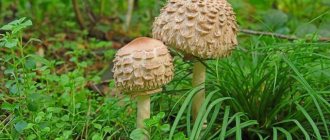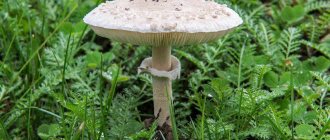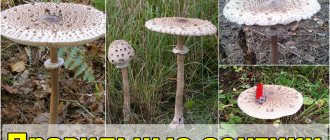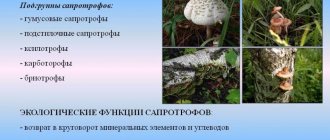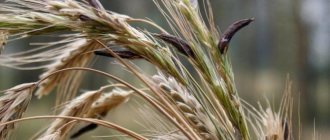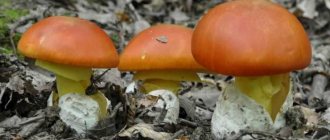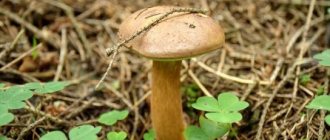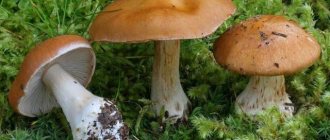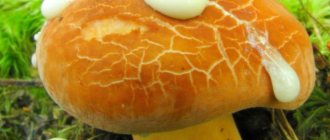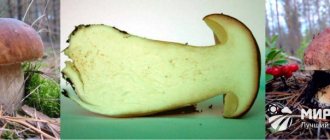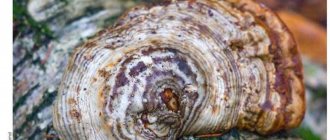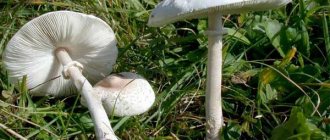Umbrella mushrooms - edible: varieties, description, photo
As you already understand, not all umbrella mushrooms are edible.
Among this species there are also poisonous representatives that can harm the human body. That is why now we will introduce you to edible types of umbrellas. They can be easily collected throughout the mushroom season and consumed after heat treatment. Types of edible umbrella mushrooms:
White.
This species has another name - field. It is called that because of its color and place of growth. As you probably already understood, its flesh is light in color. It can be white, cream or light gray. Initially, this species has an ovoid cap, which over time opens up and becomes like an umbrella. Most often found in meadows, fields and open forest edges.
Motley.
This type of umbrella, as a rule, is quite large in size. The mushroom cap is completely dry and covered with characteristic brown scales. Small dark brown growths are also clearly visible on the cap. That is why this type of umbrella has a darker shade than other relatives. The flesh of the motley umbrella is cotton-like, with a pronounced nutty odor. Likes to grow in open, well-lit areas.
Blushing
. The cap of this type of umbrella has a gray or brownish tint and a thin, almost white stem, which, as the mushroom grows, darkens and thickens at the base of the soil. The mushroom got its name due to the ability of the pulp to oxidize. If you break the umbrella cap, droplets of juice will appear on it almost immediately, which very quickly turns from transparent to reddish-brown. In addition, the red umbrella has more developed scales. Since visually they resemble a kind of fringe, sometimes a blushing umbrella is called shaggy. For growth, it selects soil that is rich in nutrients.
Maiden.
This type of umbrella is listed in the Red Book, so it is almost impossible to find it in our forests. The mushroom differs from its relatives in that it does not grow to large sizes. As a rule, the cap, even in adult representatives, has a diameter of no more than 10 cm. The girl's umbrella has a light shade of flesh and a not very pronounced mushroom aroma.
Mastoid.
It has a matte light brown cap, the edges of which are lowered down. During the dry period, the skin on the cap begins to crack and a peculiar pattern is formed on it. The main difference between the mastoid umbrella and other relatives is the presence of a pronounced tubercle in the very center of the cap. Visually, it resembles a brownish nipple.
Characteristics of the appearance of silverfish
The described insect is wingless, it has an oblong body about 1.9 cm long, a small head with antennae located on it, and three tails in the form of certain processes. The insect's paired organ of vision is faceted, with color perception of the surrounding world and ultraviolet radiation.
The most common common silverfish runs along the floor, sheer wall, quite quickly, due to the existing legs with claws. Thanks to such movements, the insect is difficult to detect, much less catch, since they hide, hiding in dark crevices and various corners of the premises.
How to cook
Cooking umbrella mushrooms is easy and quick, because you can even eat them raw in salads or on sandwiches. They are fried, stewed, soups are made with them, salted, pickled and dried.
Umbrella mushrooms in batter
Dish ingredients:
- Mushrooms - 500 grams;
- Flour - 2 tablespoons;
- Egg - 3 pieces;
- Onion (medium) - 2 pieces;
- Cheese (hard varieties) - 200 grams;
- Vegetable oil - 5 tablespoons;
- Table vinegar - 1 tablespoon;
- Salt, black pepper.
Cooking method:
- Peel the onion, cut into thin half rings, pour in vinegar, sprinkle with salt and leave to marinate for half an hour.
- Peel the mushroom caps, wash and dry.
- Beat eggs with flour, salt and pepper.
- Cut large mushrooms into several pieces.
- Heat the oil in a large frying pan, dip each piece of mushroom in the batter and fry on both sides for several minutes.
- Place onions on mushrooms.
- Grate the cheese on a coarse grater, pour it into a frying pan over the onions with fried mushrooms, turn off the heat and keep them on the stove for about five minutes so that the cheese melts.
The umbrella mushroom is one of the most delicious representatives of the mushroom kingdom. It is considered one of the varieties of champignons, although it differs from them both in appearance and taste. It belongs to the group of saprophytes, that is, those that grow on decomposing organic debris. This mushroom is distributed throughout the world, and in our country there are five of its varieties.
Despite such features, many mushroom pickers do not take it. Maybe because the edible umbrella mushroom looks like a fly agaric? But knowledgeable mushroom pickers are happy to collect young umbrellas, which grow in one place every year. Those who want to try the pleasant nutty taste of this mushroom need to know how to distinguish it from poisonous ones, where it grows and how to cook it correctly.
Ways to combat silverfish in an apartment
We have already found out that silverfish are not scary to humans directly. But living in an apartment with insects that can ruin almost any item in the house is still very unpleasant.
To get rid of the pest, you can use folk recipes (safe for home owners and their pets) or resort to the use of chemicals. Insect traps are also considered effective. Methods can be combined and combined.
Folk remedies
The simplest and most effective methods:
- Drying the premises. Silverfish are not able to live in a dry and warm room, therefore (if possible) the best method is to reduce the air humidity to 30%. The insects will run away on their own.
- Temperature conditions. Silverfish can withstand temperatures from -10 °C to +35 °C. If indoors it drops or rises beyond the critical level, the pest will not survive.
- Diatomite The product only harms insects: it does not pose a danger to humans or animals. The powder should be distributed in areas where silverfish may live, wait until the morning and vacuum up its remains along with dead insects.
- Carnation. Grind 10 grams of cloves per 100 grams of water. The resulting product can be distributed throughout the room using a spray bottle. The aroma will not only repel silverfish, but will also pleasantly refresh the atmosphere of your home.
- Citrus or lavender. You can take it directly in the form of essential oils and dilute it in water in a ratio of 5–7 drops per 100 grams of liquid, or use homemade preparations. Cut or grate the citrus peel; simply crumble the dry lavender. The product must be distributed throughout the room and renewed at least once a week for a month.
Chemicals
Chemical insect repellents are highly toxic, so they should not be used near food or personal care items. Before treating the room, you need to limit access to it for children and pets. The most commonly used drugs are:
- Boric acid. Destroys silverfish at all stages of insect development, including eggs. In liquid form, it is sprayed with a spray bottle. In powder form, it is mixed with crushed chalk in a ratio of 4:1 and scattered in places where the pest could settle.
- Pyrethrin. Sprays based on this insecticide destroy silverfish by paralyzing their nervous activity.
- Bleaching. Cleaners containing chlorine also give good results against silverfish.
- Copper sulfate. Use dissolved in water according to instructions after general cleaning. The product is applied to all surfaces on which silverfish can move, pouring into the cracks where they can hide.
The use of chemicals can provoke an allergic reaction. It is better to carry out the treatment of premises wearing rubber gloves and a respirator (bandage).
Photo gallery: basic folk and chemical remedies against silverfish
Silverfish eggs die at high and low temperatures in the house
Citrus fruits repel many insects, and silverfish are no exception.
“Perfume” made from cloves will repel silverfish and fill the room with a pleasant aroma. Pyrethrin-containing preparations are contact insecticides
Boric acid is one of the most affordable and reliable means for killing insects Diatomite (mountain meal) is effective against silverfish and is safe for animals and humans
To combat silverfish, treat all surfaces in the room with a solution of copper sulfate.
Traps
The method is highly effective and safe for others. Some traps are made by hand and do not require material costs.
- Glass jar. An artificial roughness is created outside the container so that the silverfish can climb into it. It is enough to wrap the jar from top to bottom with electrical tape or wrap it tightly with newspaper. Bait is placed inside - any leftover food. Once inside, the silverfish will not be able to get out because the glass is too slippery for it.
An ordinary glass jar can be turned into a trap for silverfish using tape and a piece of bread - Wet paper.
An ordinary newspaper is rolled into a roll, the ends are secured with rubber bands or a stapler (loosely). The structure is moistened and left near the silverfish habitat. The silverfish will not be able to resist the aroma, which is almost imperceptible to humans. She will definitely get inside, and all you have to do is get rid of the newspaper and its contents in the morning. Just don’t unwrap the trap to make sure you’ve caught a silverfish—it will certainly escape. Wet paper serves as the best bait for silverfish - Store-bought insect traps. If you don’t have the time or desire to make “traps” yourself, you can use finished products. Any mechanical trap for cockroaches and other insects will do. The same leftover food can be used as bait.
Inedible and poisonous umbrella mushrooms: types and photos
Among the umbrellas there are not only edible, but also inedible, as well as poisonous mushrooms of the genus Lepiota, a description of which is presented below:
Lepiota cristata (Agaricus cristatus)
inedible mushroom, sometimes defined as poisonous.
The mushroom cap is from 2 to 5 cm in diameter, bell-shaped in young mushrooms and convex-spread in mature specimens. The color of the cap is red-brown, its surface is covered with pointed, sparsely spaced scales of a yellow-orange or ocher tone. The stem of the poisonous umbrella mushroom is thin, hollow, up to 8 cm high, up to 0.5 cm in diameter, cylindrical in shape, slightly widened at the base. The color of the leg varies from yellowish to light cream, the ring is whitish or pinkish, very narrow and disappears quite quickly. The pulp of the mushroom is white, fibrous, has a sour taste and a sharp, unpleasant odor.
The poisonous comb umbrella mushroom is a typical representative of the northern zone with a temperate climate.
Photo credit: Strobilomyces
Photo by: Jean-Pol GRANDMONT
Photo by: Jean-Pol GRANDMONT
Lepiota castanea (Lepiota ignipes)
a poisonous mushroom with a cap 2-4 centimeters in diameter, having a reddish-brown tint. The shape of the cap is ovoid in young umbrellas and prostrate in adult mushrooms. With age, the smooth skin of the cap cracks into small chestnut-colored scales. The cylindrical leg of the chestnut umbrella is slightly expanded and pubescent at the base, the flesh of the mushroom is white, fragile, with an intense unpleasant odor. The flesh of the leg has a reddish-brown tint. The ring is narrow and white in color and disappears quite quickly. Thin and frequent plates of the fungus are initially white, which turns yellow over time.
The poisonous chestnut umbrella mushroom grows in temperate climates, is widespread in Europe, and is often found in Western and Eastern Siberia.
Rough Lepiota (Lepiota aspera, Agaricus asper, Lepiota acute squamosa)
inedible mushroom. The mushroom cap is fleshy, from 7 to 15 cm in diameter, yellowish-brown or brick-colored. In young specimens, it is fleecy-felt, egg-shaped, with age it becomes prostrate and covered with scales of a rusty hue. The leg, 7-12 cm high and 1 to 1.5 cm in diameter, has the shape of a cylinder, at the base there is a swollen tuber-shaped formation. The color of the leg is light yellow, with slightly noticeable stripes. The film ring is quite wide, white, with barely visible brown scales. The plates are frequent, white or yellowish in color. The pulp of the mushroom has a pronounced unpleasant odor, is sharp and bitter in taste.
Inedible, sharp-scaled umbrella mushrooms grow in Europe, North America and the northern part of the African continent. They bear fruit from August to October.
Photo credit: Strobilomyces
Photo by: Christine Braaten
Lepiota chestnut
Lepiota chestnut is deadly poisonous. The cap can reach 2-4 cm in diameter. Its shape can first be described as bell-ovoid, and then flat, with the presence of a small tubercle, white, with the presence of rows of scales.
The pulp can be called thin, soft, having an indefinite taste, a pleasant smell and a whitish or creamy color. Characterized by the abundant presence of loose, white, frequent and wide plates.
The leg reaches 4 cm in length. Lepiota chestnut has a cylindrical shape, widening at the base, hollow, with a quickly disappearing narrow ring, monochromatic, with a characteristic flocculent coating.
The spores are colorless and can be very smooth and elongated ellipsoidal.
The territories of Europe and the Leningrad region shelter this species, growing mostly near roads and forests. It tends to bear fruit in the summer, from July to August. Grows in small groups.
How to distinguish false counterparts of the poisonous Lepiota brick-red
There are few duplicates of poisonous lepiota in the world of edible mushrooms. Brick-red has some similarities with a number of other types of toxic lepiots.
Differences between poisonous lepiota and umbrella
Mushroom Umbrella
The danger of the mushroom is that it is similar in appearance to an edible umbrella, which is very popular among lovers of quiet hunting. The most similar to lepiota is the variegated umbrella. Even after looking at the photo, a novice mushroom picker will not always be able to understand what kind of species is in front of him.
In order not to rip off a dangerous double, you need to know the distinctive features of an edible umbrella:
- large cap - its diameter reaches 20 cm when the fruiting body ripens;
- the plates at the beginning of growth are very light, gradually turning red as they mature;
- the leg is up to 3 cm thick and up to 30 cm high.
The smell of umbrellas is nutty, but without almond notes. Other types of edible umbellifers are less similar to their poisonous counterpart due to their lighter color. The blushing umbel, which is somewhat similar to the poisonous species, can be distinguished by the reddening of the cut area.
First aid for poisoning
The appearance of the first signs of mushroom poisoning is a reason to call an ambulance. But before the ambulance arrives, you need to provide first aid to the patient:
- If the patient vomits, you need to give a lot of water or potassium permanganate solution. The liquid removes toxins from the body.
- If there is a chill, cover the patient with a blanket.
- You can use drugs that remove poisons: Smecta or activated carbon.
Attention! To prevent the patient from getting worse before the ambulance arrives, it is better to consult a doctor.
In case of mild intoxication, first aid is sufficient, but to avoid severe consequences, you should contact a clinic.
Description of poisonous lepiota
The shape of the cap of the poisonous lepiota is round, with a barely noticeable tubercle visible in the center. There are very thin radial grooves on the surface of the cap. The color of the cap is gray-red. Its surface is matte with a silky sheen. The cap is strewn with a large number of pressed scales. Its diameter does not exceed 2-7 centimeters.
The leg is low, central, cylindrical in shape. There is no thickening in the leg. It is hollow and fibrous inside. The color of the legs is pink. Its height is 2-4 centimeters. There is a very fragile whitish ring on the stem that often falls off.
The plates are concave, often located. The flesh is white, turning slightly pink when cut. The pulp has a sweetish odor, but is tasteless. The spores are white.
Variability of Lepiota poisonosa
The color of the poisonous lepiota cap varies from pink to brick red. The color of the plates is cream or white. The leg may be pink or red-brown.
Places of growth and season of poisonous lepiota
Poisonous lepiota can be found from June to August. These mushrooms grow in Western Europe and Ukraine. They settle among the grass - in meadows and parks.
Similar species
Lepiota poisonous is similar in appearance to other types of small lepiota. All small-sized lepiots should be treated with great suspicion.
Toxicity of lepiota poisonosa
This is an extremely poisonous mushroom, to be more precise, a deadly poisonous species. The only good news is that these mushrooms are frail and unsightly in appearance, and their sizes are small, so they do not attract mushroom pickers.
Other mushrooms of this genus
Lepiota spores or Umbrella is a poisonous mushroom. His hat is small, measuring 3-6 centimeters. With age, it changes from hemispherical to prostrate, while retaining the characteristic tubercle. The color of the cap is beige, white-yellow or reddish. The surface of the cap is covered with scales. The pulp is yellowish in color with a pleasant mushroom aroma. The leg is quite thin - its diameter does not exceed 0.5 centimeters, and its length is 5-8 centimeters. There is a ring on the stem, but it quickly disappears.
Lepiota spores is a rare mushroom. These mushrooms bear fruit from August to September. They grow in forests of various types. Most often found in small groups.
Bredisson's lepiota is a poisonous mushroom. Immature mushrooms have conical caps with a diameter of 2-4 centimeters, but as they ripen they become prostrate. There is a clearly visible brown-red tubercle on the cap. The surface of the mushroom is covered with white skin dotted with sparse brown scales. The shape of the leg is cylindrical. The color of the leg is fawn, and the base is purple-violet. The height of the leg reaches 5 centimeters, and the diameter up to 0.5 centimeters. But the leg has a fragile ring.
These mushrooms grow not only in forests, but also in steppes, parks, glades, and forest plantations. Bredisson's lepiota begins to actively bear fruit in the fall.
Among poisonous mushrooms, there are those species that pose a mortal danger and those that disturb the condition of the victim for some time. Lepiota poisonous belongs to the first category and can kill the one who eats it
Because of this, it is important for a lover of quiet hunting to know exactly how to distinguish this species from its edible counterparts
Why do silverfish appear and where do they live?
A silverfish that appears in an apartment hides and is sometimes difficult to detect, especially because these insects are nocturnal. This insect prefers places saturated with moist air, with condensation and water floating in it. Some areas where, for example, pipes for an aesthetic appearance are covered with tiles or something else can become such habitats for silverfish. Therefore, it is not difficult to answer the question of why silverfish are infested in a house or apartment; the climate created in these rooms is simply favorable.
These insects like to live in rooms with a temperature of 20-25, and thermobium in general is attracted to temperatures varying between 30-50. And where, so to speak, the climate will most suit their comfort, there they will create a “family nest” for themselves.
Description of the structure of a dangerous mushroom
The Latin name of the mushroom is Lepiota helveola. It is also called Lepiota brick red. This is a deadly species that belongs to the Champignon family, genus Lepiota.
The grayish-red cap of the mushroom has a diameter of 2 to 7 cm. At the beginning of the growth of the fruiting body, it is bell-shaped, later it becomes semi-rounded, and by the time of ripening it is flat or, less often, convex-spread. The tubercle in the center is grayish-brown with a cherry tint.
Dark scales are arranged in circles on the cap. By the middle they combine into a complete cover. The plates under the cap are thin, frequent, and free. At first their color is white, then it changes to yellowish-green as the mushroom matures. The spores are colorless.
The cylindrical leg has a diameter of 5 to 8 mm and a height of 2 to 4 cm. It is located centrally and may be slightly curved at the base. Its upper part is light, and its lower part is brown-cherry.
The flesh is white in the cap area and creamy on the stem. Young mushrooms have a pleasant smell and taste. The aroma is usually reminiscent of roasted almonds. As the fruiting body matures, its smell changes and is similar to a mixture of gasoline and kerosene.
https://youtube.com/watch?v=pqAm1SFbcQM%3F
A little history
The mushroom has been known for a long time, but was officially described and classified only in 1889 by the Swiss mycologist Charles-Edouard Martin and the botanist and chemist Robert Hippolyte Stode.
False umbrella mushroom: description and distribution
The umbrella mushroom is practically not popular, although it is very tasty.
Many lovers of “quiet hunting” are afraid to confuse it with pale toadstools or fly agarics. It is worth saying that the mushroom opens like an umbrella. The plates of the fruiting body are closely pressed against the stem and then assume a horizontal position. It is this resemblance to an umbrella that catches the eye of mushroom pickers. However, the umbrella mushroom has false counterparts, the consumption of which can be fatal.
False umbrella mushrooms include: comb umbel and chestnut lepiota. You can find out what the false mushroom comb umbellata looks like from the following description.
Causes and ways of the appearance of silverfish in the home
Since silverfish require darkness and moisture to exist, an insect can settle in a house for only one reason: high humidity.
There can be several ways in which a pest enters a person’s home:
- Ventilation tube.
The main entrance to the house for any insects, not just silverfish. Silverfish can easily enter a house through ventilation - Gaps, cracks, loosely closed doors and windows. The individual, due to its small size, is able to get through an almost invisible hole.
- Foreign objects containing adult insects or larvae. This could be food, boxes from the basement, books, fabrics, or any products in the manufacture of which components rich in polysaccharides were used.
You may not realize that silverfish are in your home for a very long time. These insects crawl out only in the dark and are excellent at hiding.
Description of poisonous lepiota
The shape of the cap of the poisonous lepiota is round, with a barely noticeable tubercle visible in the center. There are very thin radial grooves on the surface of the cap. The color of the cap is gray-red. Its surface is matte with a silky sheen. The cap is strewn with a large number of pressed scales. Its diameter does not exceed 2-7 centimeters.
The leg is low, central, cylindrical in shape. There is no thickening in the leg. It is hollow and fibrous inside. The color of the legs is pink. Its height is 2-4 centimeters. There is a very fragile whitish ring on the stem that often falls off.
The plates are concave, often located. The flesh is white, turning slightly pink when cut. The pulp has a sweetish odor, but is tasteless. The spores are white.
Variability of Lepiota poisonosa
The color of the poisonous lepiota cap varies from pink to brick red. The color of the plates is cream or white. The leg may be pink or red-brown.
Places of growth and season of poisonous lepiota
Poisonous lepiota can be found from June to August. These mushrooms grow in Western Europe and Ukraine. They settle among the grass - in meadows and parks.
Similar species
Lepiota poisonous is similar in appearance to other types of small lepiota. All small-sized lepiots should be treated with great suspicion.
Toxicity of lepiota poisonosa
This is an extremely poisonous mushroom, to be more precise, a deadly poisonous species. The only good news is that these mushrooms are frail and unsightly in appearance, and their sizes are small, so they do not attract mushroom pickers.
Other mushrooms of this genus
Lepiota spores or Umbrella is a poisonous mushroom. His hat is small, measuring 3-6 centimeters. With age, it changes from hemispherical to prostrate, while retaining the characteristic tubercle. The color of the cap is beige, white-yellow or reddish. The surface of the cap is covered with scales. The pulp is yellowish in color with a pleasant mushroom aroma. The leg is quite thin - its diameter does not exceed 0.5 centimeters, and its length is 5-8 centimeters. There is a ring on the stem, but it quickly disappears.
Lepiota spores is a rare mushroom. These mushrooms bear fruit from August to September. They grow in forests of various types. Most often found in small groups.
Bredisson's lepiota is a poisonous mushroom. Immature mushrooms have conical caps with a diameter of 2-4 centimeters, but as they ripen they become prostrate. There is a clearly visible brown-red tubercle on the cap. The surface of the mushroom is covered with white skin dotted with sparse brown scales. The shape of the leg is cylindrical. The color of the leg is fawn, and the base is purple-violet. The height of the leg reaches 5 centimeters, and the diameter up to 0.5 centimeters. But the leg has a fragile ring.
These mushrooms grow not only in forests, but also in steppes, parks, glades, and forest plantations. Bredisson's lepiota begins to actively bear fruit in the fall.
Lepiota brown-red
This is a deadly and poisonous mushroom, containing a huge amount of dangerous poisons and even cyanide.
Lepiota brown-red grows mostly in Western Europe. Central Asia, Russia and Ukraine are also home to it. She prefers meadows, parks and lawns. The period of active ripening occurs in mid-June and ends at the end of summer.
Lepiota brown-red is similar to agaric mushrooms because it is characterized by the presence of wide, frequent and loose plates that are creamy in color with slightly visible greenish tints.
The cap reaches a diameter of up to 3-6 cm. It can be described as convex-prostrate. The edge is slightly down. It has cream or grayish-brown, cherry shades. Dark scales cover the cap and are arranged in concentric circles. In the middle they can merge and form continuous covers of blackish-cherry shades. The leg is low and cylindrical in shape.
Definitioner
Basidia (Basidia)
Lat. Basidia. A specialized structure of sexual reproduction in fungi, unique to basidiomycetes. Basidia are terminal (end) elements of hyphae of various shapes and sizes, on which spores develop exogenously (outside).
Basidia vary in structure and method of attachment to hyphae.
Based on the position relative to the axis of the hyphae to which they are attached, three types of basidia are distinguished:
Apical basidia are formed from the terminal cell of the hypha and are located parallel to its axis.
Pleurobasidia are formed from lateral processes and are located perpendicular to the axis of the hypha, which continues to grow and can form new processes with basidia.
Subbasidia are formed from a lateral process turned perpendicular to the hyphal axis, which stops growing after the formation of one basidium.
Based on morphology:
Holobasidia are single-celled basidia, not divided by septa (see Fig. A, D).
Phragmobasidia are divided by transverse or vertical septa, usually into four cells (see Fig. B, C).
By type of development:
The heterobasidium consists of two parts - the hypobasidium and the epibasidium developing from it, with septations (see Fig. C, B) or without them (see Fig. D).
Homobasidia is not divided into hypo- and epibasidia and in all cases is considered to be holobasidium (Fig. A).
The basidium is the site of karyogamy, meiosis, and the formation of basidiospores. Homobasidy, as a rule, is not functionally divided, and meiosis follows karyogamy. However, the basidia can be divided into probasidium, the site of karyogamy, and metabasidium, the site of meiosis. Probasidium is often a resting spore, for example in rust fungi. In such cases, the probasidium germinates into a metabasidium, in which meiosis occurs and on which basidiospores are formed (see Fig. E).
See Karyogamy, Meiosis, Hypha.
Pileipellis
Lat. Pileipellis, skin - a differentiated surface layer of the cap of agaricoid basidiomycetes. The structure of the skin in most cases differs from the inner flesh of the cap and may have a different structure. The structural features of pileipellis are often used as diagnostic characters in descriptions of fungal species.
Based on their structure, they are divided into four main types: cutis, trichoderma, hymeniderma and epithelium.
See Agaricoid fungi, Basidiomycete, Cutis, Trichoderma, Hymeniderma, Epithelium.
Are these insects dangerous to humans?
Many people, having discovered silverfish in their apartment, begin to sound the alarm, not knowing anything about whether such animals are dangerous for humans. There is no harm as such from the described insects. A silverfish will not be able to get into a person’s mouth or nose, much less bite or sting.
In addition, according to widespread data from American scientists, silverfish are not carriers of any diseases or infections. But the harm from these insects is significant and lies in something completely different. The danger of their coexistence with humans lies in the following:
- Silverfish are the real enemies of all book publications standing on the shelves of a person’s closet, existing archival documents and other paper media. These insects, using certain enzymes present in their bodies, process the eaten paper components into nutrients. And the places of any paper media that silverfish have feasted on will be disfigured by fungus, yellow spots and blackening;
- The described insects defecate everywhere, spreading behind them black grains in the form of a trail. Silverfish can lay eggs or their excrement directly in flour, sugar, or on someone's sandwich;
- Being omnivorous insects, silverfish pose a real threat to items in wardrobes. Gnawing on silk, wool, cotton, linen items, these insects can switch to wallpaper, and even the glue used to glue them to the walls. Well, human food supplies, in general, are their main food - pasta and flour products, food for our smaller brothers, dried mushrooms, everything goes into consumption here.
Therefore, if a person decides to protect his life from these unpleasant insects, it is necessary to use effective control methods to get rid of silverfish once and for all.
Mushroom preparations for umbrellas for the winter
How nice it is on a frosty winter evening to gather your family around the table with warm potatoes, crispy cucumbers and a plate of pickled gifts from the forest - mushrooms. Mushrooms from jars are also used for filling pizzas, pies and pies. The description of the preparation is quite simple and even a novice housewife can do this preparation.
You can also prepare fried mushrooms for future use. After cooking, they are placed in sterile jars and hidden in the refrigerator. This preparation will ideally complement the taste of boiled potatoes. And if you add fresh herbs and homemade sour cream to the dish, then this dish will allow the hostess to collect a bouquet of compliments to her skill.
Umbrella mushrooms can be dried. Such mushrooms are subsequently used to prepare sauces and soups; their shelf life is approximately 1 year.
Useful properties and contraindications
Thanks to its excellent taste, the umbrella mushroom is a favorite item for quiet hunting. It is better to collect umbrella mushrooms when they are young. In addition, they must be subjected to thorough heat treatment. Very young umbrellas are successfully pickled, mature mushrooms are dried, salted and boiled, after which they are used to prepare broths, sauces, main courses, salads and fillings for pies and pancakes.
Umbrella mushrooms contain many substances beneficial to the human body:
- vitamins of group B, as well as C, E, K;
- potassium (up to 16%), sodium, magnesium, calcium, iron, phosphorus;
- tyrosine;
- arginine;
- beta glucans;
- melanin.
According to traditional healers, extracts and tinctures from umbrella mushrooms, as well as direct consumption of these mushrooms, help fight a number of serious ailments, including:
- vascular and heart diseases;
- rheumatism;
- nervous system disorders;
- oncological diseases.
The use of umbrella mushrooms is contraindicated for:
- diseases of the gastrointestinal tract,
- pancreatitis,
- pregnant women,
- children under 5 years old.
Despite its dubious appearance, the beneficial effect of the umbrella on the human body has been noted for a long time:
- Fighting cancer. Beta-glucans and melanin contained in umbrella mushrooms have a positive effect on the entire body and the immune system in particular. They stabilize the metabolic process and stimulate its work. This effect is a strong barrier against cancer.
- Improves the functioning of the cardiovascular system. Its use improves the functioning of the hematopoietic organs and also strengthens blood vessels. It also helps relieve heaviness from heart problems.
- Fighting depression. When used regularly, it has a beneficial effect on brain function and helps avoid anxiety and mental exhaustion.
- Normalization of the thyroid gland. The composition includes riboflavin (vitamin B2), which has a positive effect on the function of the thyroid gland, and it also protects the skin, hair, and nails.
- Establishing metabolism. The microelement PP helps accelerate metabolic processes.
- Release of “bad” cholesterol. Lecithin, which is part of the mushroom, rids the body of excess cholesterol and balances its level.
Contraindications
This representative of the mushroom kingdom is considered safe, but to avoid health problems, you need to familiarize yourself with the contraindications to its use:
- Individual intolerance.
- Increased bladder function.
- Liver diseases.
- Diseases of the intestines, stomach and pancreas.
- Children under 6 years of age and pregnancy.
How to eat umbrella mushrooms?
Umbrella mushrooms get very fried. You need to be prepared for the fact that a huge basket of forest trophies after roasting will turn into a small portion. It is better to take young, closed heads, which are cut and fried in heated vegetable oil until excess moisture evaporates. Next, add onions, salt, pepper and cook for about 45 minutes.
Umbrellas in batter are considered one of the most delicious dishes. Properly prepared mushroom is very tasty. Beat the eggs vigorously, add ground crackers and flour, salt, pepper and roll the prepared caps. Heat a lot of vegetable oil in a cast iron frying pan and place the cap heads. A beautiful golden brown color and persistent aroma are a sign that the dish is ready.
You can easily prepare a delicious and aromatic soup from forest umbrellas. The water is salted and the forest trophy is soaked in it for a couple of hours. Then washed and cut into pieces. Potatoes, carrots and onions are cut into pieces. Fry onions and carrots in sunflower oil. Boil the mushrooms for 20 minutes. First add potatoes, after 15 minutes - fry and greens. The soup is consumed with rich sour cream and fresh bread. The aroma of this dish will bring everyone at home to the kitchen table.
Types of insects
Sugar silverfish
There are more than 600 species of silverfish all over the world, about 10 species live in Russia. They differ from each other mainly in color and habitat. For example, the following types of described insects are found in houses and apartments:
- Silver silverfish (also called sugar fish);
- A common variety of the described insect;
- Home thermobia.
Thermobia
But the last type of silverfish differs from the other two varieties described above in the characteristic color of the body, which is variegated gray-brown.
The silverfish, this is another type of described insect, lives in soil saturated with limestone. The combed silverfish lives on the southern coast of Crimea in places saturated with water vapor.
Comb type of silverfish
White umbrella mushroom is... What is white umbrella mushroom?
| White umbrella mushroom |
| Scientific classification |
| Latin name |
| Macrolepiota excoriata (Schaeff.) Wasser, 1978 |
| Synonyms: |
|
White umbrella mushroom
(lat.
Macrolepiota excoriata
) - a mushroom of the champignon family. Russian synonyms:
Field umbrella mushroom
Description
The cap is 6-12 cm in diameter, thick-fleshy, initially ovoid, elongated, opens up to flat-spread, with a large brown tubercle in the center. The surface is whitish or creamy, matte, the center is brown and smooth, the rest of the surface is covered with thin scales remaining from the rupture of the skin. Edge with white flaky fibers.
The flesh of the cap is white, with a pleasant smell and slightly tart taste; it does not change when cut. The stalk is longitudinally fibrous.
The stalk is 6-12 cm high, 0.6-1.2 cm thick, cylindrical, hollow, with a small tuberous thickening at the base, sometimes curved. The surface of the leg is smooth, white, yellowish or brownish below the ring, slightly brownish when touched.
The plates are frequent, with smooth edges, free, with a thin cartilaginous collarium, easily separated from the cap, there are plates. Their color is white, in old mushrooms it is from cream to brownish.
Remains of the bedspread: the ring is white, wide, smooth, mobile; Volva is missing.
Spore powder is white.
Microscopic signs
Spores are 12-15×8-9 µm, ovoid, with a germination pore, colorless, pseudoamyloid, metachromatic, with one or more fluorescent droplets.
The plate tram is correct.
The hyphae of the scales are fusiform or cylindrical, 40-50×12-15 µm, often with a cap-shaped thickening at the ends.
Basidia are four-spored, club-shaped, 35-40×12-15 µm.
Cheilocystids are fusiform, colorless, thin-walled, 50×10 µm.
Color chemical reactions
Reactions of plates with α-naphthol and pulp with aniline and guaiacol are negative; The pulp with lactophenol turns brown, with phenolaniline it gives a purple-pink color.
Varieties
- The main form of Macrolepiota excoriata var. excoriata or Macrolepiota excoriata f. excoriata - the center of the cap is bare, darker (to brown), the rest of the surface is finely scaly.
- Macrolepiota excoriata var. squarrosa (R.Mre) Wasser, 1978 - Cap with detached scales. Known in North Africa, in oak plantations.
- Macrolepiota excoriata f. barlae Babos, 1974 - creamy-brown cap with thin or large scales of various shapes, known in parks and gardens of Hungary.
Ecology and distribution
Soil saprotroph. It grows both on the edges of mixed and coniferous forests, along clearings and clearings, in plantations, and in meadows, pastures, and the steppe. It grows singly or in groups and is common.
Distributed throughout Europe, in Asia - Turkey, Iran, Transcaucasia, Central Asia (Kyrgyzstan, Turkmenistan, Uzbekistan), Siberia (Altai Territory, Buryatia, Krasnoyarsk Territory), China, Far East (Khabarovsk Territory, Primorsky Territory), Japan, in North America, South America (Chile), Australia and Africa (Algeria, Morocco, Tunisia, Kenya, Congo, Nigeria, South Africa) and on the islands - Sri Lanka, Philippines, Cuba.
Season:
June - October.
Similar species
Edible:
Poisonous:
Lepiota helveola is a highly poisonous mushroom, usually much smaller in size (up to 6 cm). It is also distinguished by its gray-pink skin of the cap and pinkish flesh.
Inexperienced mushroom pickers may confuse this umbrella with the deadly poisonous fly agaric, which is found only in forests, has a free volva at the base of the stem (it can be in the soil) and a white smooth cap, often covered with membranous flakes.
Nutritional quality
An edible mushroom of excellent quality, used in the same way as the variegated umbrella mushroom. Can successfully complement meat dishes.
Literature
- Wasser S.P.
Flora of mushrooms of Ukraine. Agaric mushrooms / resp. ed. I. A. Dudka. - K.: “Naukova Dumka”, 1980. - P. 301-303, 53.
Vavrish P.O., Gorovoy L.F.
Mushrooms in the forest and on the table. - K.: "Harvest", 1993. - P. 113-114. — ISBN 5-337-00728-9 All about mushrooms / comp. V. Buldakov. - Donetsk: PFC "BAO", 2000. - P. 138. - ISBN 966-548-124-X Mushrooms: Directory / Transl. from Italian F. Dvin. - M.: “Astrel”, “AST”, 2001. - P. 64. - ISBN 5-17-009961-4
Udu J.
Mushrooms. Encyclopedia = Le grand livre des Champignons / trans. from fr. - M.: “Astrel”, “AST”, 2003. - P. 113. - ISBN 5-271-05827-1
Description of Lepiota cristata.
At a young age, the shape of the cap of Lepiota combata is convex, later it becomes flat-convex, and a tubercle is expressed in the center. Its diameter is 2-5 centimeters. The color of the cap is whitish, on the surface there are red-brown scales located concentrically, and the tubercle is red-brown in color.
The pulp of Lepiota comb is thin, with a pungent radish odor and unpleasant taste. The color of the flesh is white, but when broken it turns red.
Under the cap of this lamellar mushroom there are loose, frequently spaced plates. The spores are triangular in shape. The color of the spore powder is white.
The leg is cylindrical in shape, smooth, slightly thickened towards the base. Its diameter is 0.3-0.8 centimeters, and its height is 4-8 centimeters. The leg is hollow inside. Its color is yellowish or slightly pinkish. There is a membranous ring on the stem. The color of the ring is white, sometimes with a pink tint. When the mushroom is fully ripe, the ring disappears.
Places where Lepiota cristata grows.
This type of lepiot can be found in deciduous, mixed forests and coniferous forests; in addition, they can settle in vegetable gardens, meadows, and pastures. Fruiting in Lepiota crest occurs from July to October. In addition to our country, these mushrooms also grow in North America.
Evaluation of the edibility of Lepiota crestata.
Lepiota comb is not only inedible, but also possibly poisonous. Although similar in appearance to other edible lepiotes, Lepiota combata has no nutritional value in any form.
If Lepiota combata accidentally gets into food, it can cause severe poisoning, which is accompanied by diarrhea, vomiting, acute abdominal pain, headaches and cramps.
The comb umbrella not only contains toxic substances, it is capable of accumulating radionuclides that have a negative long-term effect on the body. Increased doses of radionuclides kill cells, stop their division process, and damage DNA.
False doubles of the poisonous umbrella
In the Russian region, there are several species of twins of the scaly poisonous umbrella. First of all, this is champignon. How to distinguish a poisonous mushroom from an edible one?
At first glance, they look similar, but the edible champignon has a fleshy, dense leg. In cross-section, it has no voids, and the leg of its poisonous double is hollow inside (this can be seen in the cross-section). This is the most striking distinguishing feature. The champignon has a cap surrounded by a so-called skirt. The poison umbrella does not have it.
Champignon
The next double is the field (white) umbrella. This mushroom is edible. The main differences from its poisonous counterpart: flakes hang like lace along the edges of the cap. The color of the cap is white-gray, without reddish inclusions (like lepiota). In a young sharp-scaled umbrella, the ring around the stem easily moves down, and in the white edible umbrella, the ring sits tightly on the stem.
Field (white) umbrella
The blushing umbrella or shaggy one is an edible mushroom. If you press on the cut flesh, it will oxidize and turn brownish with a slight red tint. The hat is beige. The scales are circular, not pyramidal. This mushroom is often confused with the very poisonous rough umbrella. They can be distinguished by the unpleasant odor and peppery, pungent taste of the inedible pulp.
Umbrella blushing
Russula is also an edible mushroom. Unlike lepiota, it has a greenish or grayish cap. The leg resembles a potato tuber. There is no ring on it. On the underside of the cap you can see white plates.
Russula
We bring to your attention photos that show the main differences between poisonous umbrellas and edible ones.
Differences between brown-red lepiota and edible umbrella
Useful, edible umbrella mushrooms have a cap reaching up to 30-35 cm in diameter. Its color can be beige, white, brown (almost beetroot). The leg is fleshy and thick. The thickness is about 3 cm, and the height reaches 30 cm. In the upper part there is a ring that does not disappear in adult mushrooms.
The diameter of the chestnut lepiota does not exceed 7 cm. The stem is thin and brittle. The length does not exceed 4 cm. The hat is grayish in color with red-brown splashes. The ring on the stalk is present only in young mushrooms. Adults do not have such a ring. Young specimens have an almond-honey aroma, while adults smell unpleasantly of acetone or gasoline.
How to distinguish an edible umbrella mushroom from a poisonous toadstool and fly agaric (with video)
To know the difference between edible and poisonous umbrella mushrooms, also watch the video. It will help you more accurately identify existing differences.
For example, how to distinguish an umbrella mushroom from a fly agaric? The fly agaric has scales on its cap, but they are rare. Usually the caps of this mushroom are almost smooth, with a small number of white scales. The umbrella is gray or brown with large white or gray scales. The umbrella leg is framed by three layers of white ring that slides down easily.
Many mushroom pickers confuse umbrellas with white toadstools and get poisoned. Therefore, the question arises: how to distinguish an umbrella mushroom from a toadstool?
Toadstool is a very toxic mushroom, and if accidentally consumed, death occurs in 90% of cases. The entire mushroom has a grayish or off-white tint. Its cap does not have scales, but is covered with flakes. The flesh of the white toadstool has a rather unpleasant chlorine odor. There is no ring on the stem; it disappears very early, leaving fragments of fiber instead.
